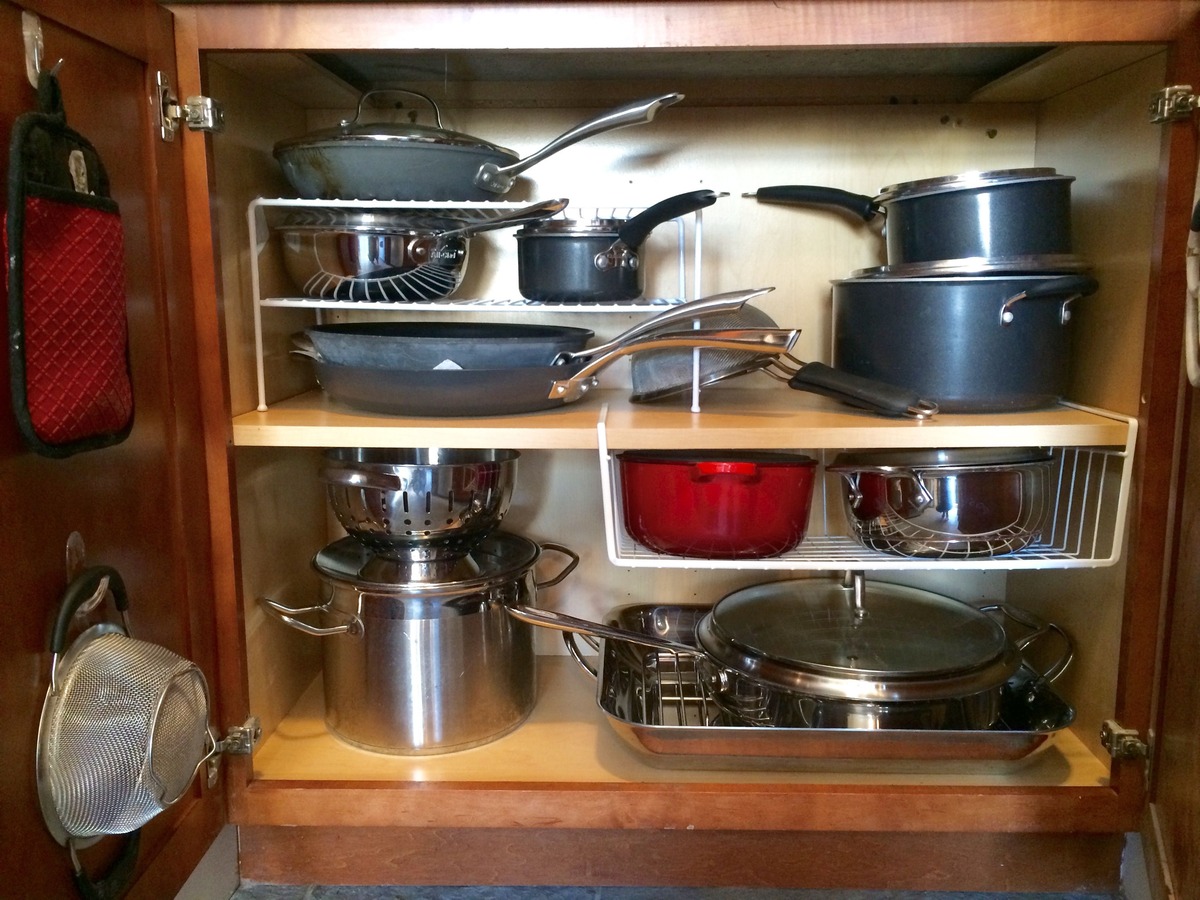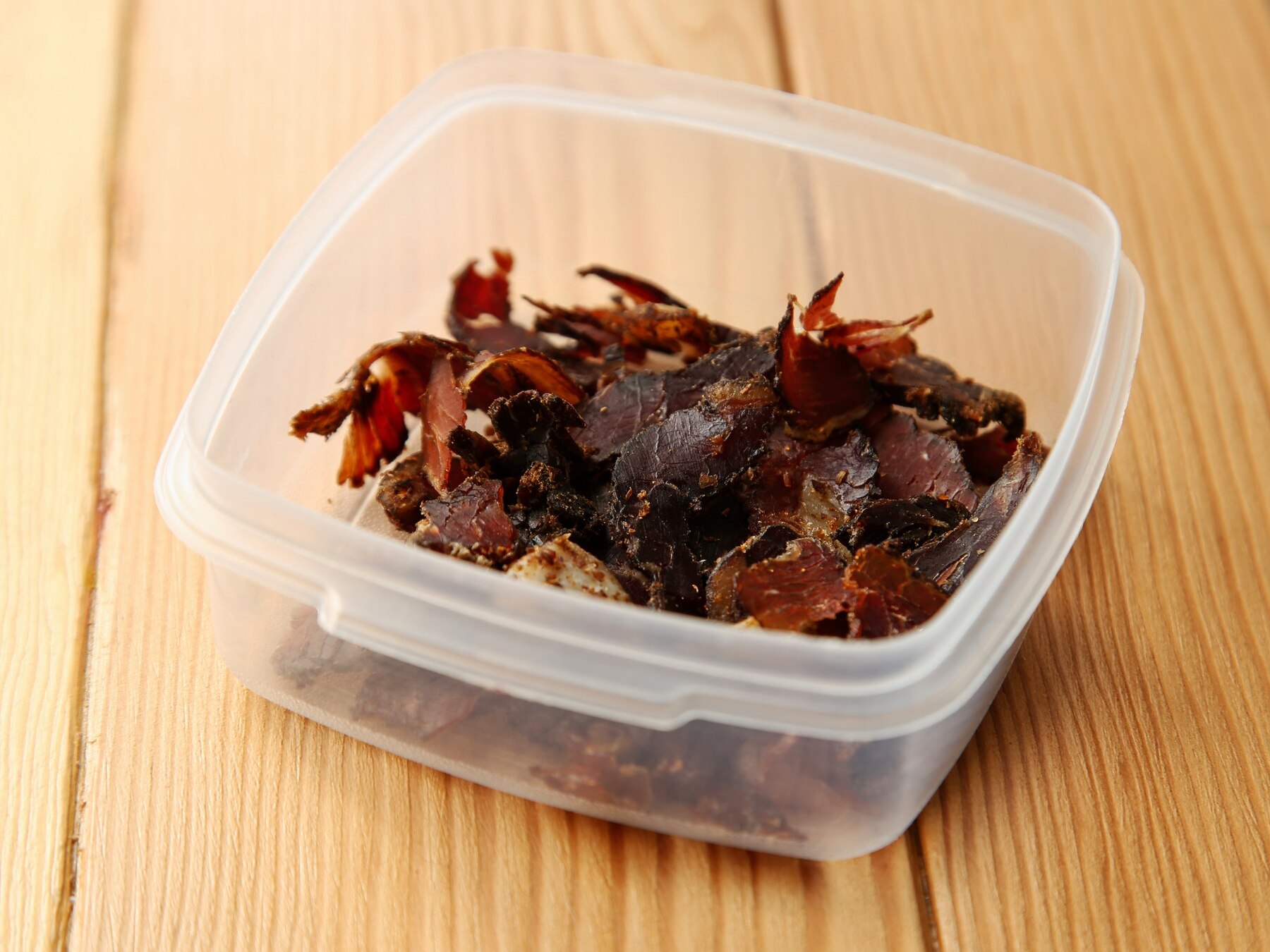

Articles
How To Store Croissants
Modified: December 7, 2023
Learn how to store croissants and keep them fresh for longer with these helpful articles.
(Many of the links in this article redirect to a specific reviewed product. Your purchase of these products through affiliate links helps to generate commission for Storables.com, at no extra cost. Learn more)
Introduction
Croissants are a beloved pastry known for their flaky, buttery layers and delightful taste. Whether you have freshly baked croissants or leftovers from a bakery run, proper storage is essential to maintain their freshness and prevent them from going stale or becoming dry. In this article, we will explore the importance of storing croissants correctly and provide you with helpful tips on how to store them to keep them as delicious as possible.
When it comes to storing croissants, there are a few key factors to consider. The choice of storage container, the method of wrapping the croissants, the ideal storage conditions, and whether or not freezing is an option, all play a role in preserving the quality of these delectable pastries. Let’s dive into the details and learn how to store croissants effectively.
Key Takeaways:
- Proper storage is crucial to maintain the flaky texture, buttery taste, and overall quality of croissants. Airtight containers, proper wrapping, and avoiding refrigeration are key to preserving their delightful freshness.
- Freezing croissants allows for long-term storage while maintaining their taste and texture. Properly wrapping, labeling, and thawing techniques ensure that frozen croissants can be enjoyed with the same flakiness and deliciousness as freshly baked ones.
Read more: How To Store Fresh Croissants
Why is Proper Storage Important?
Proper storage is crucial to maintain the freshness, texture, and flavor of croissants. When exposed to air or improper storage conditions, croissants can quickly become stale, dry, or lose their delicate flakiness. By storing them correctly, you can extend their shelf life and ensure that every bite remains just as delicious as the first.
One of the main reasons to store croissants properly is to preserve their flaky texture. Croissants are made up of layers of butter and dough, which create that signature flakiness. However, exposure to air can cause the butter to oxidize and the layers to lose their distinct texture. Proper storage, such as using airtight containers or wrapping them tightly, helps to prevent this oxidation and maintain the desired flaky consistency.
In addition to texture, proper storage also helps to maintain the croissants’ taste. Croissants have a delicate, buttery flavor that can easily be compromised if they are not stored correctly. For example, leaving them out in the open can expose them to odors and humidity in the environment, leading to a loss of their original taste. By storing them in airtight containers or wrapping them tightly, you can safeguard their flavor and ensure that every bite is as delicious as it should be.
Moreover, proper storage prevents croissants from drying out. The flaky layers of croissants are achieved through a process called lamination, where layers of butter and dough are folded together. When croissants are exposed to air, the moisture within them evaporates, causing them to become dry and lose their pleasant texture. By storing them in airtight containers or wrapping them tightly, you can retain the moisture and prevent them from drying out.
Another reason for proper storage is to prevent the growth of mold and bacteria. Croissants, like any baked goods, are susceptible to mold growth if not stored correctly. Exposure to moisture or high humidity levels can provide an ideal environment for mold and bacteria to develop, which can affect the quality and safety of the croissants. By storing them in airtight containers or freezing them, you can significantly reduce the risk of mold growth and keep your croissants fresh and safe to consume.
In summary, proper storage is important to preserve the flaky texture, delicious taste, and overall quality of croissants. By taking the necessary steps to store them correctly, you can extend their shelf life, prevent them from drying out, and ensure that every bite is as enjoyable as the first.
Choosing the Right Storage Container
When it comes to storing croissants, selecting the right storage container is essential to maintain their freshness and protect them from external elements. Here are a few options to consider:
- Airtight Containers: Airtight containers, such as Tupperware or glass containers with a tight-fitting lid, are an excellent choice for storing croissants. These containers create a seal that prevents moisture, air, and odors from entering, keeping the croissants fresh for a longer time. Make sure to choose a container that is spacious enough to accommodate the croissants without squashing them.
- Plastic Wrap: If you don’t have airtight containers, you can use plastic wrap to tightly wrap individual croissants. Start by placing a croissant on a piece of plastic wrap, then fold the sides and ends of the plastic wrap over the croissant, ensuring there are no exposed areas. This method helps to protect the croissant from air and moisture, keeping it fresher for a shorter period. However, be cautious not to press too tightly, as it can flatten the delicate layers.
- Paper Bags: Another option is to use paper bags to store croissants. This method allows air circulation while still providing some protection from moisture and foreign odors. However, it is important to note that croissants stored in paper bags may become slightly drier within a shorter time compared to airtight containers or plastic wrap.
- Bread Boxes: If you have a bread box or bread bin, you can store croissants in it. Bread boxes create a semi-enclosed space that helps to maintain the right level of moisture while protecting the croissants from excessive air exposure. However, make sure the bread box is clean and free from any odors that could transfer to the croissants.
- Re-sealable Bags: For short-term storage, you can use re-sealable plastic bags to store croissants. Place the croissants in the bags and press out as much air as possible before sealing. While this method is not as effective in preventing staleness as airtight containers or plastic wrap, it can still provide adequate protection for a day or two.
When choosing a storage container, it is important to consider the size and quantity of croissants you need to store. Ensure that the container is large enough to accommodate the croissants without overcrowding or squishing them, as this can affect their shape and texture.
Remember, the key is to prevent air, moisture, and odors from reaching the croissants to maintain their freshness. By selecting the appropriate storage container, you can safeguard the quality of your croissants and enjoy them for an extended period.
Wrapping Croissants for Storage
Properly wrapping croissants is crucial to maintain their texture, freshness, and taste when storing them. The right wrapping technique helps to protect the croissants from air exposure, retain moisture, and prevent them from drying out. Here are some tips on how to wrap croissants effectively:
- Individual Wrapping: If you plan to store the croissants individually, it is best to wrap each croissant separately. This prevents them from sticking together and makes it easier to thaw or reheat them later.
- Use Plastic Wrap or Foil: When wrapping individual croissants, use plastic wrap or aluminum foil. Start by placing the croissant on a sheet of plastic wrap or foil, then fold the sides and ends over the croissant to completely cover it. Ensure it is wrapped tightly, but be careful not to press too hard, as it can flatten the delicate layers of the croissant.
- Avoid Exposed Areas: Make sure that all areas of the croissant are fully covered by the wrapping material. Leaving any part exposed can lead to moisture loss and affect the freshness of the croissant. Ensure a tight seal to protect the croissant from air and prevent it from drying out.
- Label and Date: If you are storing multiple croissants or have different batches, it is helpful to label and date each wrapped croissant. This helps you keep track of how long they have been in storage, making it easier to prioritize consumption and maintain freshness.
- Store in a Ziplock Bag (Optional): If you have wrapped the croissants individually, you can further protect them by placing them in a re-sealable plastic bag. This secondary layer of protection helps to prevent any potential moisture or odor penetration, especially if you are storing them in the refrigerator or freezer.
By wrapping croissants properly, you create a barrier that prevents air from reaching the croissants, thereby maintaining their texture and flavor. It also helps to retain moisture and prevent them from drying out, ultimately preserving their delightful taste.
Remember that the wrapping technique is crucial, especially if you plan to store the croissants for an extended period or freeze them. With proper wrapping, you can prolong the shelf life of your croissants and enjoy them whenever you crave their flaky goodness.
Storing Croissants at Room Temperature
Storing croissants at room temperature is an ideal option if you plan to consume them within a day or two. However, it is important to follow the right steps to maintain their freshness and prevent them from becoming stale. Here’s how to store croissants at room temperature:
- Airtight Container or Bag: Place the croissants in an airtight container or re-sealable plastic bag. Ensure that the container or bag is clean and free from any odors that could transfer to the croissants.
- Store in a Cool, Dry Place: Find a cool and dry spot in your kitchen or pantry to store the croissants. Avoid areas that are exposed to direct sunlight or heat, as this can cause the croissants to become stale quicker.
- Avoid Refrigeration: Croissants are best enjoyed at room temperature and refrigeration can accelerate the staling process. It is recommended to avoid refrigerating croissants unless they are filled with perishable ingredients like cream or custard.
- Consume within a Day or Two: Croissants stored at room temperature are best consumed within one to two days to ensure maximum freshness. As time goes by, they start to stale and lose their flakiness.
It’s important to note that croissants stored at room temperature may lose their freshness and become drier compared to those stored in the refrigerator or freezer. If you don’t plan to consume them within the recommended timeframe, it’s best to consider freezing them for longer-term storage.
By following these guidelines, you can store croissants at room temperature and enjoy them at their best for a short period. Remember to check them daily and consume them before they lose their texture and taste.
Store croissants in an airtight container at room temperature for up to 2 days. For longer storage, freeze them in a resealable plastic bag for up to 1 month. Reheat frozen croissants in the oven at 350°F for 10 minutes.
Read more: How To Store Costco Croissants
Freezing Croissants for Long-Term Storage
Freezing croissants is an excellent option if you want to extend their shelf life and enjoy them at a later time. When frozen properly, croissants can be stored for several weeks without compromising their taste and texture. Here’s how to freeze croissants for long-term storage:
- Cool Croissants: Allow the croissants to cool completely before freezing them. Freezing warm croissants can result in the formation of condensation, which can make them soggy when thawed.
- Wrap Individually: Wrap each croissant individually with plastic wrap or aluminum foil. Make sure to cover them tightly, leaving no exposed areas. This helps to prevent moisture loss and protect the croissants during freezing.
- Double-Bagging: Place the individually wrapped croissants in a re-sealable plastic bag and press out as much air as possible before sealing. Double-bagging provides an extra layer of protection against freezer burn and helps maintain the croissants’ quality.
- Label and Date: It’s important to label the bags with the date of freezing. This helps you keep track of their freshness and prioritize consumption.
- Freeze: Place the wrapped croissants in the freezer and make sure they are positioned in a way that they won’t get squished or flattened by other items in the freezer. It is recommended to place them on a flat surface or a baking sheet before freezing and then transfer them to a freezer-safe bag or container once they are solid.
When properly frozen, croissants can be stored in the freezer for up to 2-3 months. Beyond that, they may start to lose their quality and become stale.
To enjoy frozen croissants, it’s essential to follow the proper thawing and reheating methods to ensure they regain their flakiness and deliciousness.
Please note that freezing can slightly alter the texture of the croissants. While they may not be as fresh as when they were first baked, proper freezing techniques help to preserve their overall taste and quality.
By freezing croissants using these guidelines, you can have a stash of delicious pastries ready to be enjoyed whenever you crave them!
Thawing and Reheating Frozen Croissants
Thawing and reheating frozen croissants properly is crucial to bring back their flaky texture and delicious taste. Here’s the step-by-step process to ensure your frozen croissants are warmed to perfection:
- Remove from Freezer: Take the desired number of frozen croissants out of the freezer. It’s best to thaw only the amount you plan to consume to avoid refreezing.
- Thawing Options: There are a few methods you can use to thaw your frozen croissants:
- Room Temperature: Place the croissants on a plate or baking sheet and let them thaw at room temperature for 2-3 hours, or until fully thawed. This method allows the croissants to gradually come to room temperature without becoming soggy.
- Oven Thawing: Preheat your oven to a low temperature (around 250°F/120°C). Wrap the frozen croissants in aluminum foil and place them on a baking sheet. Put the sheet in the preheated oven for 10-15 minutes, or until the croissants are fully thawed.
- Refrigerator Thawing: If you have time, you can thaw the croissants in the refrigerator overnight. Simply transfer the frozen croissants to the refrigerator and let them thaw slowly for 8-10 hours.
- Reheating Options: Once the croissants are thawed, you can reheat them to restore their flakiness and warm them for a delightful eating experience:
- Oven Reheating: Preheat your oven to around 325°F/165°C. Place the thawed croissants on a baking sheet and heat them for 5-7 minutes, or until they are warmed through. Keep a close eye on them to prevent over-browning.
- Toaster Oven Reheating: If you have a toaster oven, you can use it to reheat the croissants. Slice the thawed croissants horizontally and place them in the toaster oven for a few minutes until warmed and crispy.
- Microwave Reheating: While reheating croissants in the microwave may not retain their original flakiness, it can be a quick option. Wrap the thawed croissant in a damp paper towel and microwave it for 15-20 seconds on medium power. Be careful not to overheat, as it can make the croissant chewy.
After reheating, allow the croissants to cool slightly before enjoying. The reheated croissants should have a crispy exterior and a soft, flaky interior, just like freshly baked ones.
Remember, it’s best to consume the reheated croissants immediately after reheating for the best flavor and texture. Avoid reheating them multiple times, as it can cause them to become dry.
By following these thawing and reheating methods, you can enjoy the deliciousness of your frozen croissants as if they were just freshly baked!
Tips for Maintaining Freshness
To ensure your croissants stay fresh and delicious for as long as possible, here are some helpful tips to keep in mind:
- Consume Fresh Croissants First: If you have both fresh and stored croissants, it’s best to enjoy the fresh ones first. Croissants are at their peak freshness and flavor when freshly baked, so prioritize consuming them within a day or two.
- Store in Small Batches: When storing croissants, it’s recommended to store them in smaller batches rather than all at once. This allows you to minimize exposure to air and maintain the freshness of the remaining croissants.
- Avoid Excessive Handling: Croissants are delicate pastries, and excessive handling can lead to them losing their flaky texture and becoming flat. Try to handle them gently when wrapping, storing, and reheating.
- Reheat as Needed: Instead of reheating all the stored croissants at once, only warm up the ones you plan to eat to avoid reheating and potentially drying out the entire batch.
- Don’t Refrigerate Unnecessarily: While croissants can be stored at room temperature for a short time, refrigeration should be avoided when possible. Refrigeration can accelerate the staling process and adversely affect the texture and flavor of the croissants.
- Don’t Overcrowd: Whether in the storage container or freezer, make sure not to overcrowd the croissants. Give them enough space to breathe and prevent them from getting crushed or flattened.
- Wrap Tightly: When wrapping croissants, ensure they are tightly sealed to prevent air exposure and moisture loss. Use plastic wrap, foil, or airtight containers to maintain their texture and freshness.
- Keep Away from Odorous Foods: Croissants can absorb odors from their surroundings, so it’s recommended to store them away from strongly scented foods like onions, garlic, or spices to preserve their original flavor.
- Properly Label and Date: Always label and date your stored croissants to keep track of their freshness. This will help you prioritize consumption and ensure you enjoy them at their best quality.
By following these tips, you can maximize the freshness and quality of your croissants, allowing you to savor their deliciousness for an extended period.
Conclusion
Croissants are a delightfully flaky and buttery pastry that brings joy to our taste buds. Proper storage is essential to preserving their freshness, texture, and delicious flavor. Whether you have freshly baked croissants or leftovers from a bakery run, following the right storage techniques will help you enjoy them at their best.
Choosing the right storage container, such as airtight containers or plastic wrap, plays a vital role in maintaining the croissants’ quality. Wrapping them tightly prevents air exposure, retains moisture, and protects them from drying out. If you plan to consume the croissants within a day or two, storing them at room temperature in an airtight container is recommended. However, for long-term storage, freezing is an excellent option.
Freezing croissants allows you to extend their shelf life for several weeks. Properly wrapping and labeling them before freezing helps preserve their texture and taste. Thawing frozen croissants using various methods and reheating them to regain their flakiness enhances their enjoyment when you’re ready to indulge.
To maintain the freshness of croissants, consider consuming freshly baked ones first and storing the remaining ones in small batches. Avoid unnecessary refrigeration and overcrowding. Take care not to overhandle the delicate pastries and keep them away from odorous foods. Properly labeling and dating the stored croissants will help you keep track of their freshness.
In conclusion, with the right storage techniques and a little extra effort, you can ensure that your croissants remain fresh, flaky, and delicious for as long as possible. Whether you enjoy them straight from the bakery or savor them later from the freezer, these delightful pastries will always bring a little taste of indulgence to your day.
Frequently Asked Questions about How To Store Croissants
Was this page helpful?
At Storables.com, we guarantee accurate and reliable information. Our content, validated by Expert Board Contributors, is crafted following stringent Editorial Policies. We're committed to providing you with well-researched, expert-backed insights for all your informational needs.















0 thoughts on “How To Store Croissants”